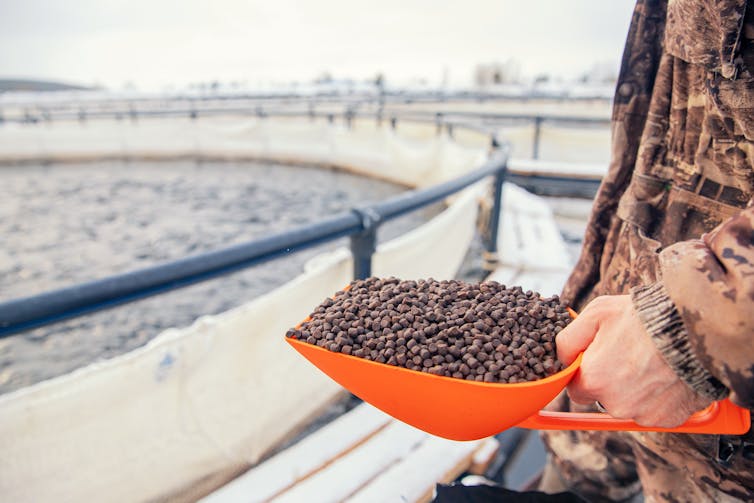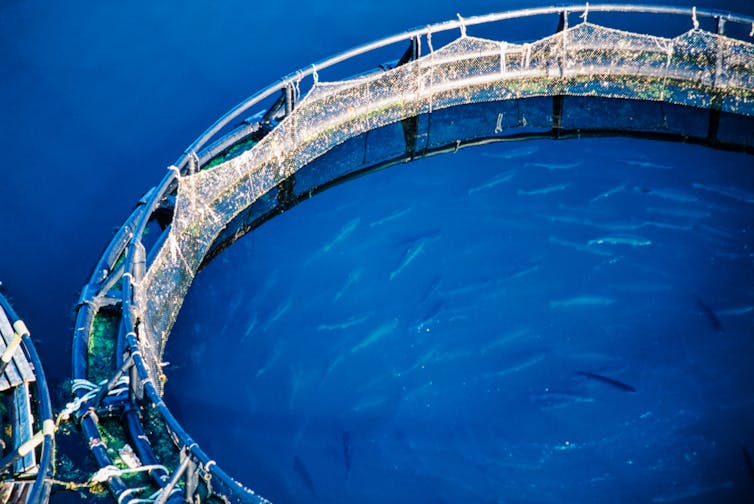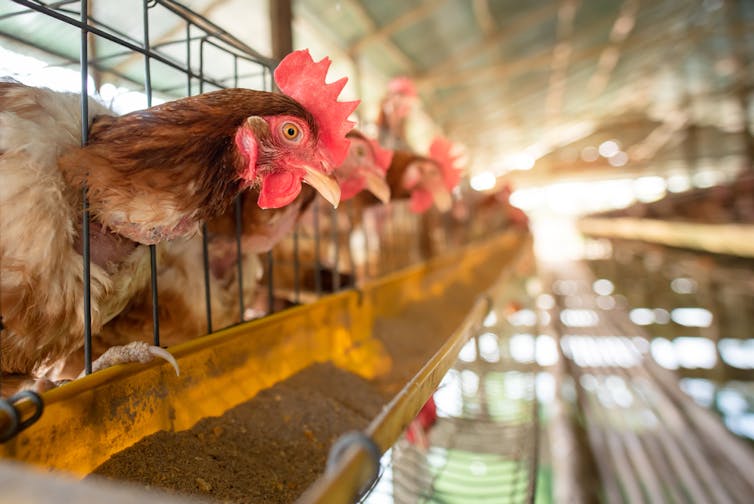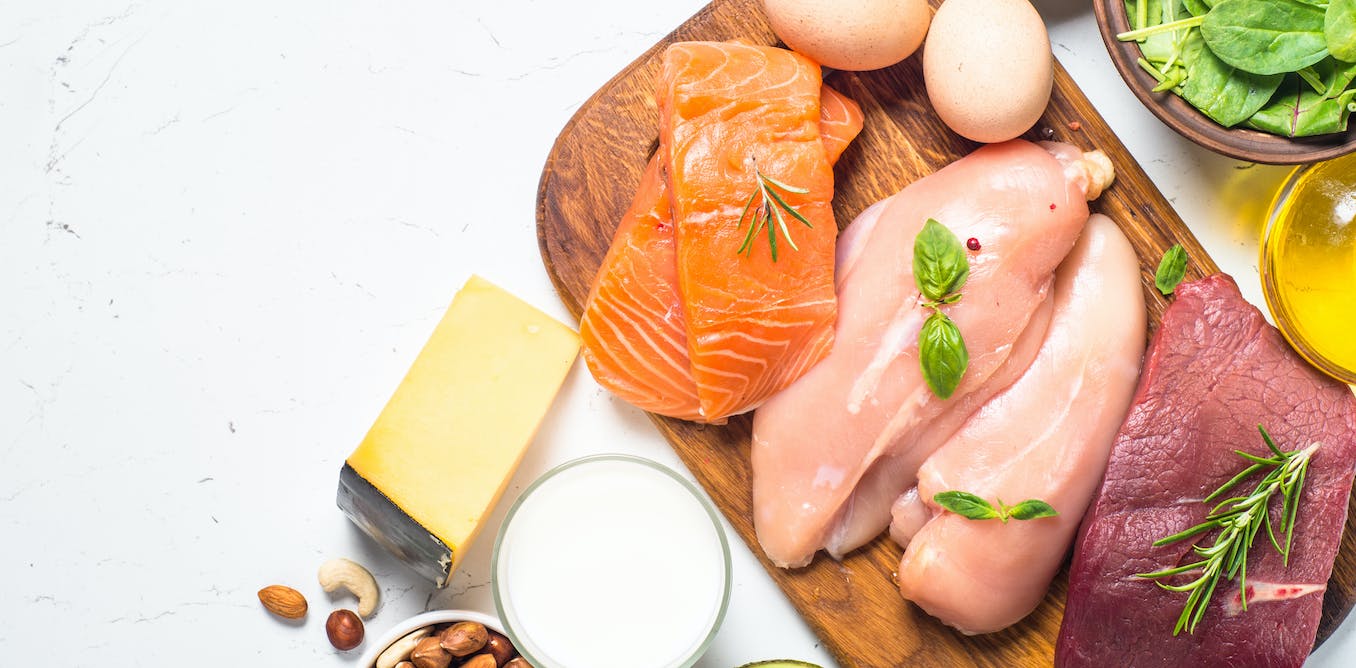Switching from meat to plant-based protein is one way to reduce greenhouse gas emissions and consume less of the planet’s natural resources.
But while chicken and salmon are often considered better choices than red meat, how do we calculate their true impacts?
In our new research, we set out to quantify the environmental footprint of broiler (meat bird) chicken and farmed salmon production, considering greenhouse gas emissions, nutrient pollution, land or sea disturbance, and freshwater use.
With a more comprehensive understanding of the pressures on the environment from these food production systems, we can confirm both are better than beef or pork, and chicken is slightly better than salmon, but neither is as responsible as plant-based foods.
Environmental pressures add up
Environmental pressures from broiler chicken and farmed salmon occur not only on the farm where the animals are raised but also at the source of the feed.
Both chicken and salmon are typically fed legumes and grains such as soybean and wheat, as well as fishmeal and oil from herrings, anchovies and sardines. That’s why their environmental footprints cover both land and sea.
While farmed salmon and chicken are among the most environmentally efficient fed animal products from their respective realms, their production nevertheless puts considerable pressure on the environment.

from www.shutterstock.com
Major sources of greenhouse gas emissions include energy used in these intensive farming operations, and methane and nitrous oxide from animal excrement. Farms can manage these emissions by choosing to use renewables, reducing energy use by being more efficient, and better managing animal waste.
Disturbance considers the land and sea area taken up by farm infrastructure as well as the area used to produce feed. On land, feed disturbance is more straightforward as land clearing displaces habitats and animals to grow crops. For fisheries, it is more complex since different types of fishing gear cause different levels of disturbance to habitats and fish are caught.
Freshwater is used to irrigate crops, provide drinking water for animals, and service water for cleaning pens and cooling animals.
Nitrogen and phosphorus from animal excrement and synthetic fertilisers can pollute the surrounding environment. Run-off or discharge into waterways is a major source of nutrient pollution, which can cause algal blooms.
We combined these four pressures into a single metric and mapped its distribution across the world.
This allowed us to understand where and how much environmental pressure chicken and salmon production exert on the environment to better inform food system sustainability.
Global environmental footprints: where does Australia stand?
We found farmed chicken and salmon have huge environmental footprints, but the vast majority (95%) were concentrated in just 5% of the world. The countries with the largest “chicken footprints” are the United States, China and Brazil. For salmon, Norway, Chile and the United Kingdom top the list. These countries are also the largest producers.

from www.shutterstock.com
Australia seems to have more environmentally friendly farms for both chicken and salmon, compared with other countries.
For chicken, Australia just scrapes into the top 20 biggest producers (out of 224 chicken-producing countries) but is in the top tier for environmental efficiency at the farm site. We define efficiency as the environmental pressure per tonne of food produced.
For salmon, Australia is the sixth-largest producer (out of 11 commercially producing countries) and has the second best efficiency. Maintaining or improving this efficiency now and in the future will help make Australia a leader in sustainable food production.
Australia mostly produces crops for chicken and salmon feed, rather than marine ingredients. Several countries produce similar levels of feed with better feed efficiency scores, so there is room for improvement.
Chicken or salmon?
Compared with salmon, chicken has lower environmental efficiency across all categories except freshwater use. This can partly be explained by the bird’s life cycle: six or seven chickens can typically be produced in the same location in a given year, taking 6-8 weeks to reach slaughter weight, whereas salmon can take 12-24 months to reach harvestable size (excluding the land-based freshwater period).

from www.shutterstock.com
Higher greenhouse gas emissions for salmon are likely due to the large source of greenhouse gas emissions form salmon waste in the form of nitrous oxide. Higher disturbance in salmon can be traced back to the large footprint of fishmeal and fish oil production from capture fisheries used in feed. We assumed no freshwater use in on-farm production of salmon, only crop feed production, explaning chicken’s higher freshwater use.
On the question of whether it’s better to eat one or the other, it’s worth considering local conditions and effects on the environment. High freshwater use in a drought prone area, for example, is likely to have more detrimental effects on habitats and species nearby.
In general, fed animals have higher environmental footprints than non-fed products such as crops and shellfish. But if you like to eat meat, then chicken and salmon are both good options compared with beef and pork.
Pathways to sustainability
Feed was a large source of environmental pressure in our study, accounting for 78% of broiler chicken and 67% of salmon pressures.
Some might be surprised that chicken has an environmental footprint in the sea. That’s because more than 520,000 tonnes of fishmeal and fish oil is used to feed chickens.
Similarly, salmon has a footprint on land. We found some 2.3 million tonnes of crops such as soybean and wheat were used in their feed.
Reducing the pressure on the environment from salmon and chicken farming would require changes to feed ingredients, where feed is sourced, or production areas. For example, because we included ocean disturbance from fisheries in our metric, we found that crops are generally more environmentally efficient feed ingredients than fishmeal or fish oil. However, this switch would likely increase the competition for resources, such as land and water, from these two production systems.
Novel feed ingredients such as microalgae, bacteria or insects have the potential to replace fish in feed, further reducing pressure on the environment from salmon and chicken farming, but cost of feed and affects on nutrition also need to be considered.
Manure management could also play a bigger role, as it contributes to both nutrient pollution and greenhouse gas emissions.
Blurring the lines between the land and sea
Our study provides fresh perspective to the debate around food system sustainability, with a big-picture view of the four main environmental pressures from chicken and salmon farming.
These production systems bridge the divide between land and the sea. Raising chickens involves extracting resources from the marine environment as well as cropland. Similarly, salmon are fed from both the ocean and the land.
This leads to questions over resource competition, production advancements in aquaculture relative to chicken production, and how changes in feed choice or availability may alter the footprints of these food sectors in the future.
But for now, on the important question of what to eat for dinner, it’s fair to say that both farmed salmon and chicken are environmentally friendly options, with chicken only slightly ahead on the sustainability stakes.
Of course, if you really want to do the right thing by the planet, you might like to reduce your meat intake and seek plant-based protein sources.
Environmental footprint calculators have one big flaw we need to talk about




